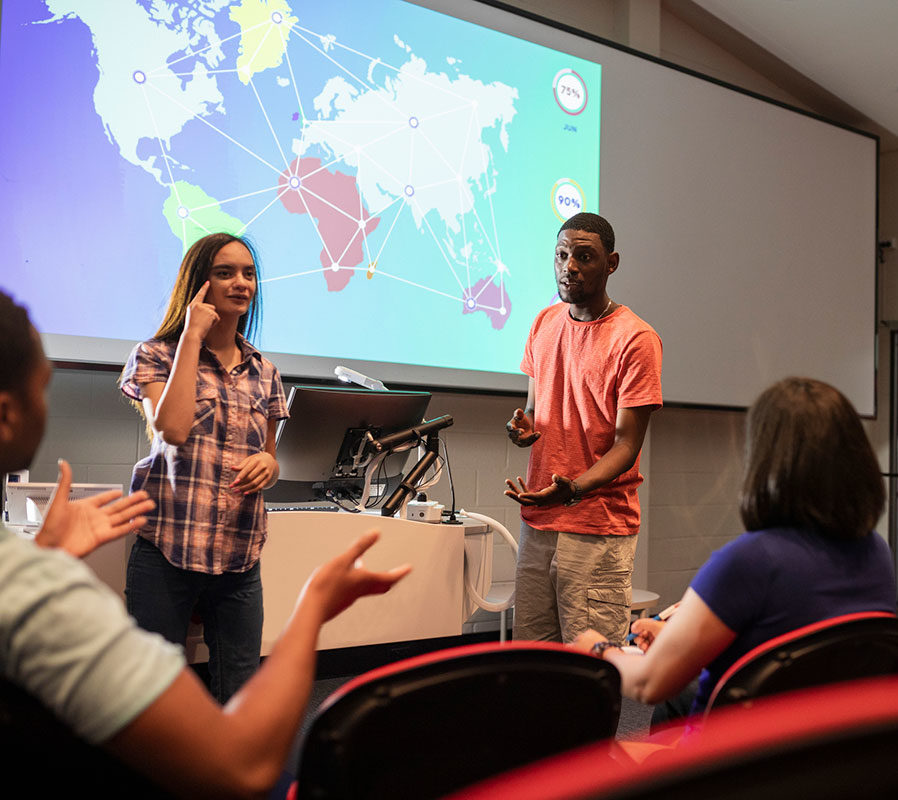Introduction
Reducing and removing barriers to ensure accessible teaching and learning spaces can feel like a big topic to tackle. However, one of the barriers to consider is the way we think about and approach accessibility. Shifting our thinking from individual accommodations to creating a culture of accessibility for all students makes for a positive and inclusive learning experience for everyone.
Throughout this article, we will look at strategies and ideas that can be used to help you create that culture within your teaching and learning spaces. The article will suggest ideas and strategies that you can use when planning your space and content delivery. These ideas and suggestions are strongly embedded in universal design principals and will look at physical space, content delivery, communication, and working collaboratively to support a learning environment that is accessible to all.
AODA and UDL
The Accessibility for Ontarians with Disabilities Act (AODA) has set out to design, implement, and ensure accessibility standards for all Ontarians with Disabilities by the year 2025. They added “design of public spaces” in 2014, but do not yet have guidelines that are specific to education settings.
As professionals and educators, we can use guidelines from the “design of public spaces” and incorporate a Universal Design approach to create teaching and learning spaces such as labs, classrooms, and meeting rooms in a way that creates an accessible and inclusive experience for as many students as possible (Burgstahler, 2012).
Physical Space (Classrooms/Labs/Meeting Spaces)
When considering your physical space, the goal is to remove as many physical barriers as possible to support inclusion for all in the classroom. Below is a list of ideas to consider in the design and set up of your spaces.
- Whenever possible choose rooms with moveable and sizeable desks and chairs (Burgstahler, 2012).
- Provide the choice to sit or stand, and the choice of where to sit or stand (Dolmage, 2015).
- Keep aisles and traffic spaces clear and uncluttered.
- Consider lighting. Is the room well-lit while students move to their seats? Can the lighting be adjusted afterward to accommodate vision impairment or light sensitivities?
- Ensure there is enough space that students can leave if they need to.
- Use a variety of visuals (indicating exits, front and back of room, or specific spaces, arrows for traffic flow).
- At the beginning of a course, provide verbal information about accessible exits, elevators, washrooms etc. (Dolmage, 2015).
- Inform students that they can leave if needed (it is okay to ask them to do this in the least disruptive way) and that they can stand/sit/move/stretch throughout if necessary.
- Manage background noise and distractions (Dolmage, 2015).
- Ensure your office space where students may meet with you considers all of these accessibility suggestions.
Individual Accommodations
- Some students may have an accommodation for priority seating in the class. This could be at the front, back, or near an exit.
- Ensure that students who have this accommodation have access to the appropriate space in the class.
- You may be inclined to use visuals to reserve these spaces, however, check with the student first if they are okay with that. Many students will not want to be identified in that way.
- Encourage students with this accommodation to come to class a bit early if possible to choose the best spot for their needs.
Content Delivery
It is also important to offer accessible and inclusive content and expectations. Below are many ideas you can incorporate into the delivery of your course content.
- Setting the stage for open communication around needs may make students more comfortable letting you know what their needs are. Start your course by identifying this and what some of your needs are as the person speaking.
- Face towards the class when speaking as often as possible (Dolmage, 2015).
- Provide a clear goal/purpose for your lecture and let students know where you plan to begin and end (Dolmage, 2015).
- Be aware of your pace when speaking (too fast, too slow).
- Highlight key points throughout and provide opportunity for discussion of these points.
- Provide teaching and learning plans that give students relevant information, assessment and assignments dates, course goals and concrete examples of expectations. Consider including a statement on the first page about your institution’s accessibility services.
- If available, use a microphone.
- Post notes, scripts, lecture slides, pictures before class whenever possible. If it was not possible before class, post after (Dolmage, 2015).
- Make large print copies of all materials and handouts available (Dolmage, 2015).
- Use high contrast between background and text on hand outs and slides (light background/dark text).
- Provide verbal explanation of visual information.
- Provide concrete examples and templates for assignments.
- Re-explain difficult concepts and examples in simpler language (Dolmage, 2015).
- When showing videos, use closed captioning (Burgstahler, 2012).
Interaction
- Communicate with students in a way that lets them know you are willing to accommodate their needs and preferences.
- Create a comfortable, respectful and inclusive environment (Burgstahler, 2012).
- Be willing to work with additional support staff, EA’s, sign interpreters.
- Make intentional connections with students.
- Provide alternative ways for students to ask questions, anonymous note cards, in emails after class, office hours.
- Avoid spontaneously calling on students in class.
As we work toward a common goal to shift our thinking to a culture of accessibility, we may still experience situations where individual accommodation is necessary to support students. When presented with a unique situation, remain open minded, flexible, and willing to work with that person to meet their accessibility and accommodation needs. Your institution has accessibility consultants/advisors that you can reach out to for collaboration on accommodations (both universally and individually).
Summary/Key Takeaways
To summarize, using as many of the above ideas, in a Universal Design model, and shifting your thinking from individual accommodation to accessibility for all will help to create positive and inclusive environments. Using some of the ideas and suggestions in this article to design your physical space, delivery course content and working collaboratively with students, supports and staff from your institution will help you in creating Accessible Teaching and Learning Spaces.



